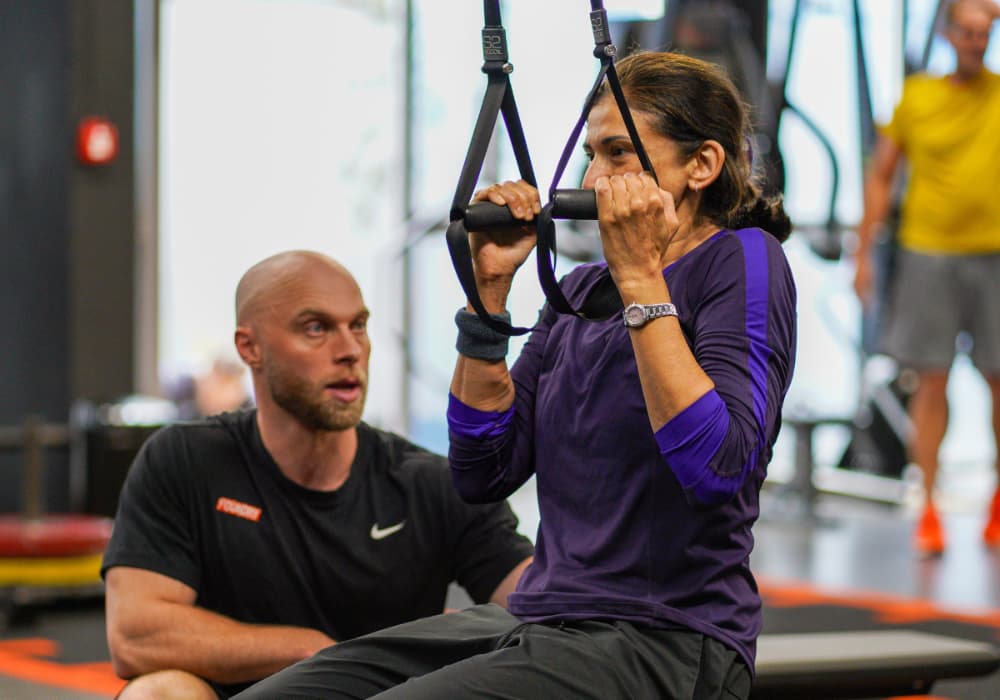
Categories
Core Exercise for Lower Back Pain
Core training is a crucial component of any well-rounded fitness program. It becomes even more critical if you’re suffering from lower back pain. Specific core exercises can help strengthen and support your spine, alleviating discomfort and promoting a healthy, strong lower back. Here are some of our favourite core exercises for lower back pain patients.
It’s estimated that 2.5 million people in the UK experience back pain on any given day. Movement, when managed correctly, can often alleviate this problem. At our Personal Training Gym, we support clients with various spinal issues, from fused spines to herniated disks to inflamed facet joints. Core training, in particular, plays a significant role in managing and reducing lower back pain.
Effective Core Exercises
Stir the Pot
This exercise is excellent for those with some foundational strength and who want to intensify their plank routine, maximising core development.
- Assume a plank position; rest your elbows on a stability ball and keep your body straight.
- Brace your abs and tighten your glutes to prevent your back from sagging.
- Move your forearms in a circular motion, maintaining a solid position throughout.
- Adjust the difficulty by widening or narrowing your stance.
Forearm Side Plank
The side plank targets the obliques and helps stabilise the spine, reducing lower back strain.
- Lie on your side with your forearm on the ground and elbow directly under your shoulder.
- Lift your hips off the ground, creating a straight line from your head to your feet.
- Hold this position, engaging your core and keeping your hips elevated.
- Switch sides and repeat.
Pallof Press
This exercise trains the core to resist rotation, a key function for spinal stability.
- Adjust a cable or attach a resistance band at chest level.
- Stand to the side of the attachment point, feet slightly wider than shoulder-width apart, knees slightly bent.
- Pull the handle or band towards your chest, creating tension.
- Press the handle or band straight out in front of your chest, resisting the sideways pull by tightening your abdominal area.
- Hold for five to seven seconds and slowly release back to your chest.
- Do ten reps, then switch sides.
Bird Dog
This exercise enhances stability and coordination, targeting the core and lower back muscles.
- Start on your hands and knees, ensuring your back is flat and your core is engaged.
- Extend your right arm forward and your left leg back, maintaining balance.
- Hold for a few seconds, then return to the starting position.
- Repeat with the opposite arm and leg.
Dead Bug
The dead bug exercise helps improve core stability and coordination while reducing strain on the lower back.
- Lie on your back with your arms extended towards the ceiling and your knees bent at a 90-degree angle.
- Slowly lower your right arm and left leg towards the floor, pressing your lower back into the ground.
- Return to the starting position and repeat with the opposite arm and leg.
Tips for Managing Lower Back Pain
-
Work in Controlled Ranges of Motion
Due to differences in skeletal structure and flexibility, not everyone can exercise the same way. Be aware of your capabilities and reduce the range of motion to avoid aggravating injuries.
-
Reduce Axial Loading
Axial loading compresses the spine and should be minimised for those with back pain. Work with your trainer to load exercises correctly and progress safely without adding unnecessary weight.
-
Warm Up Properly
Proper warm-up routines that mobilise joints and activate muscles help stabilise the lower back before training. This is especially important for the glutes and abs, which are often underactive due to prolonged sitting.
-
Sit Less
Prolonged sitting can exacerbate back pain. Make a conscious effort to stand and move around frequently throughout the day, even to make a cup of tea or walk around during phone calls.
-
Improve Your Posture
Focus on maintaining good posture when sitting, standing, and moving. Efficient movement reduces strain on the back and helps alleviate pain.
Core Videos
YouTube links to pre-Foundry (W10) vids:
- Core Workout
- Core Finisher
- Core Circuit with Resistance Band
- Core for Lower Back Pain – Part 1
- Core for Lower Back Pain – Part 2
If you have any questions on the above or would like some advice on how we could help you with your fitness goal, don’t hesitate to visit one of our personal training gyms in London and speak to one of our personal training coaches.
Related Articles
- Exercises To Help You Get a Well Conditioned Core
- Can Exercise Banish Lower Back Pain?
- 5 of the Best Exercises for Lower Back Pain
- Rectifying RDLs Causing Lower Back Pain
- Our Top Five ‘Core’ Training Tips

